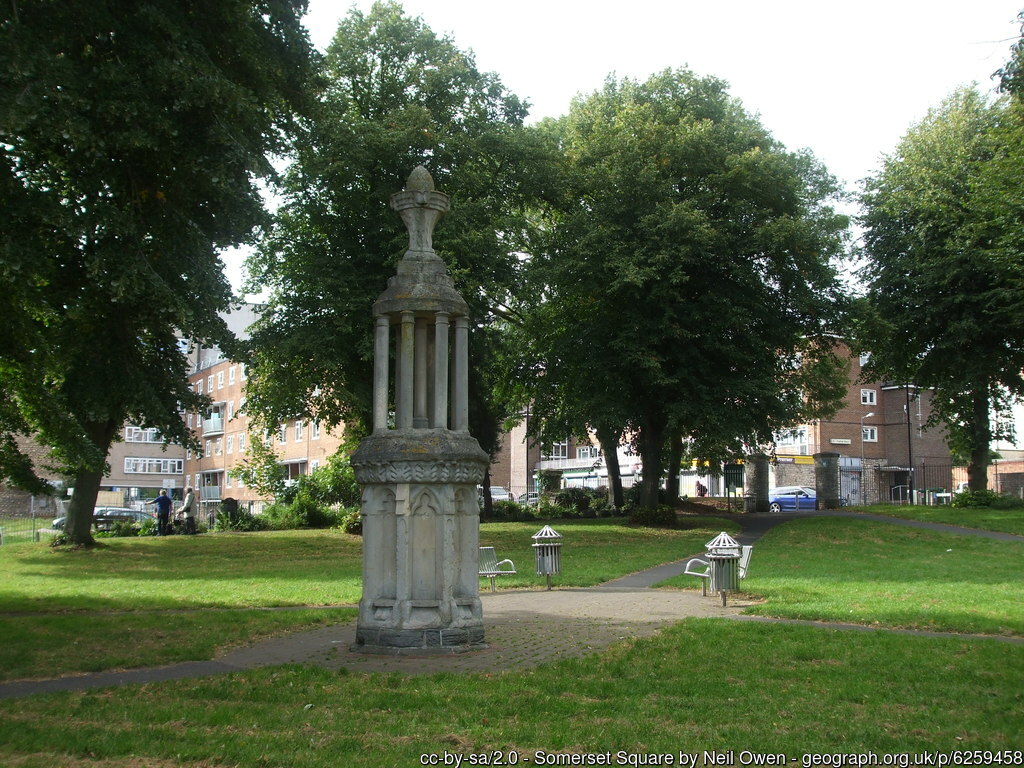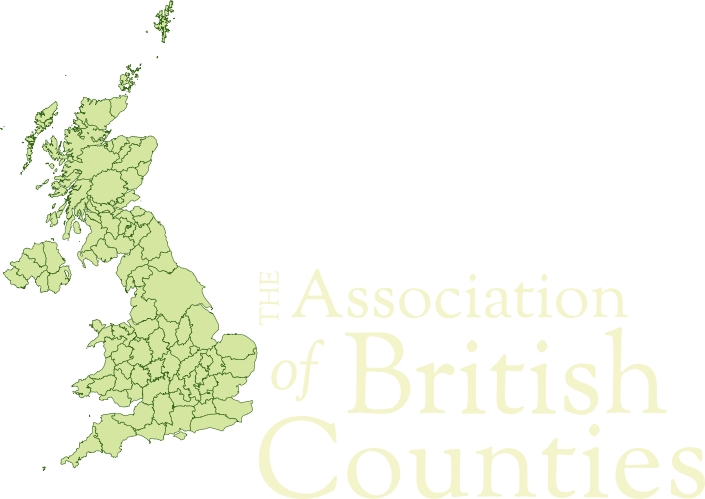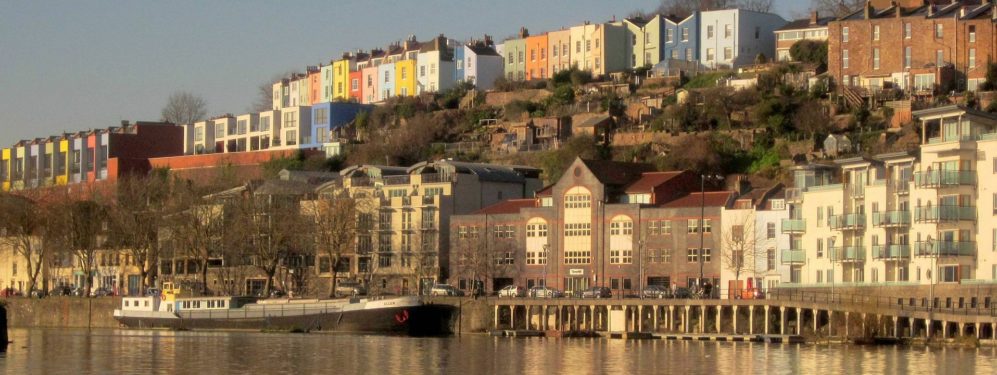The short answer to this question, of course, is that Bristol lies partly in Gloucestershire and partly in Somerset, with the old course of the River Avon (e.g. along the Floating Harbour) forming the border. Nonetheless, it is occasionally claimed that the ‘county corporate’ status granted to Bristol in 1373 removed Bristol from its parent counties and made it a county equivalent in every respect to them. ABC’s latest Factsheet presents a detailed look at this matter:
The border of Gloucestershire and Somerset in Bristol
As the Factsheet illustrates, the general approach from 1373 to the present day has been to both highlight Bristol’s ‘county corporate’ status but also to acknowledge its place within both Gloucestershire and Somerset. There is no contradiction in this, providing one views ‘county corporate’ status as an extra civic dignity rather than as signifying that those towns given this status have literally becomes counties equivalent to Gloucestershire, Somersetshire, Wiltshire and the rest.
Innumerable maps, reference works and official documents illustrate this approach. The First Edition (1771) of Britannica was published nearly 400 years after Bristol was made a county corporate but still clearly describes it as “partly in Gloucestershire, and partly in Somersetshire”.

Joan Blaeu’s 1667 map of Gloucestershire clearly show Bristol in the two counties with the Avon as the border.

The General Register Office (GRO) in its Census reports consistently stated that Bristol lay partly in Gloucestershire and partly in Somerset, see e.g. the 1881 Census report for Gloucestershire.

Numerous other reference works did likewise. For example, the Somersetshire Archæological and Natural History Society, in the minutes to their 1887 Proceedings, stated:
“Bristol, as you are no doubt aware, is one of the few places in England which are counties in themselves. But in common parlance it is considered as being partly in Gloucestershire and partly in Somersetshire, and we are proud of our connection with these two counties – two of the most fertile and beautiful in England. The largest part of Bristol lies to the north of the Avon and is therefore in Gloucestershire; and this portion of Bristol contains about a third part of the population of that county. But the Ward of Redcliff, and the large and rapidly increasing suburb of Bedminster, lie to the south of the Avon and therefore in Somersetshire, and contain in that part of Bristol a population equal to that of the largest city in the county.”
As the city expanded southwards in the nineteenth century, there was clearly a deliberate effort to reflect and celebrate the Somerset identity of this part of the city. There are several street and building names using the name ‘Somerset’.

In the 21st century we are all too used to the tiresome problem of ‘county confusion’, i.e. the use of the word ‘county’ to describe administrative areas (local government and ceremonial) and the misuse of historic county names as the names of some of these areas. This absurd situation continues to have a deleterious effect on the identities of our historic counties.
However, before 1888 the only ambiguity concerning what was or was not a ‘county’ concerned the status of the co-called ‘counties corporate’: those towns or cities which various statutes had given the title ‘county of a town’ or ‘county of a city’ along with some of the administrative functions normally associated with a county, e.g. sheriff, courts of Assize, courts of Quarter Sessions. In fact, these did not really cause any great confusion because they were simply never treated as equivalent to the historic counties. Of the 20 counties corporate in England and Wales, Bristol is the only one for which the claim is ever made that the ‘county corporate’ status literally made it a county.
The notion of being a ‘county corporate’ had ceased to have any practical significance by the end of the 19th century. Despite this, the phrase ‘city and county’ persists in relation to Bristol. It seems likely this is mainly due to its use by the pre-1974 local authority. The modern Bristol council area is actually a factor of 35 times larger than that of the original City and County of Bristol. This does not stop it erecting boundary signs proclaiming the whole of this area to be ‘Bristol – City and County’. In recent years, the phrase ‘city and county’ has also been arbitrarily applied to Cardiff Council and Swansea Council, despite neither ever having had ‘county corporate’ status.

Councils do not need to pretend to be counties to build strong corporate identities. Instead they should embrace the historic counties in which they lie, especially as a part of their heritage and tourism activities. ABC wants to see an end to the use of the word ‘county’ as it relates to administrative areas and bodies. An end to the use of the ‘city and county’ phrase would be a welcome part of this.


10 thoughts on “Which county is Bristol in?”
Misuse of the term ‘county’ has gone unchallenged for too long. It sounds ‘official’. ‘Tyne and Wear County Council’ was scrapped in 1986 but various institutions still use its badge and flag.
As an Association we need to push hard for a review of the Lord Lieutenancies Act 1997, which used the 1972 Local Government Act as the structure for ‘ceremonial counties’. Lord Lieutenants, their Deputies and High Sheriffs on this basis reinforce the notion of ‘Cleveland’ and ‘Tyne & Wear’ as formal entities and not defunct administrative areas. The ‘Metropolitan County of Tyne & Wear’ should be scrapped, once and for all.
The younger generation have no memory of the historic and traditional counties and are puzzled when challenged. ‘Cumbria’ suffers the same unfortunate legacy.
No coincidence that Heath introduced all this bureaucratic and unnecessary nonsense at exactly the same time as he took us, undemocratically, into what became the EU.
No doubt the impending changes to the UK’s Parliamentary Constituencies will further muddy the waters. It could only happen here!
The loss of its High Sheriff and Lord Lieutenant in 1996 or soon after means “Cleveland” has already been wiped off the ceremonial map of England. How inconsistent it was of them to “return” Stockton and Hartlepool to County Durham but not Gateshead or Sunderland, especially since “Tyne and Wear” appears to have had – even as late as the mid 1990s – no official body representing it apart from a fire and rescue service.
“Cleveland” and “Humberside”, on the other hand, each had not just a fire and rescue service with which there were no plans to do away, but a police force on top of that. As none of this stopped the powers that be from appreciating that getting rid of them as ceremonial entities was desirable nonetheless, why they didn’t have the same attitude towards “Tyne and Wear”, “Merseyside” etc. is beyond me.
ABC wants to see an end to the use of the word ‘county’ as it relates to administrative areas and bodies. An end to the use of the ‘city and county’ phrase would be a welcome part of this. – Agreed
There must be an official Pariamentary county covering that area between Somerset and Gloustershire.Stop mudying the waters with past nomenclature!
The aim of the full article (in the PDF) is to un-muddy the waters. Perhaps this doesn’t come across is the much shorter piece on the website.
This article seems to be trying very hard to prove that Bristol is not really a county at all, and that perhaps even its inhabitants did and do consider the city to be partly in Gloucestershire and partly in Somerset. That is, of course, nonsense. Since 1373 – and that’s a very long time – Bristol has been entirely self-governing (with the exception of during the existence of the short-lived county of Avon) and has not in any sense come under the jurisdiction of it neighbouring counties. The citizens of Bristol are well aware of this, and even more so since the 600th anniversary commemorations in 1973 and the more recent 650th commemorations in 2023. Publications that have insisted that Bristol was partly in Gloucestershire and partly in Somerset are simply wrong. The boundaries commission of 1887 reaffirmed that Bristol should be “neither in the county of Gloucester nor of Somerset for any purpose whatsoever” . The Avon (Structural Change) Order 1995 that abolished the county of Avon reinstated Bristol’s county status:
“6 (1) New counties of North West Somerset, Bath and North East Somerset, South Gloucestershire and the City of Bristol shall be constituted.” In 1373 the notion of a ‘corporate county’ did not exist. A county was a county, and nothing else. There were no different sorts of counties. Bristol these days, as well has having the status of a county, is defined as a unitary authority. In fact, it has been a unitary authority since 1373 (except for the short Avon interregnum) having complete administrative control over its own affairs, without any connection to any other county. Even the City of London, also designated as a county, comes under the administrative control of the Mayor of London. Unlike any other unitary authority, Bristol has enjoyed county status for more than 650 years and nobody in Bristol considers themselves to be in any other county, in common parlance or in any other way .
Bristol had been self-governing for some 200 years by the time Christopher Saxton’s maps were produced, but that didn’t stop him from depicting the city as split between Gloucestershire and Somerset. What’s more, my father’s road atlas from 1966 quite clearly shows Bristol in Gloucestershire (wholly in that county, admittedly), and there is no reason at all for me to think it was exceptional for its time in doing so. Back in those days, the people of Britain, mapmakers included, could distinguish between counties and council areas far better than the general population can today – hence why Rutland, and not any city (Newcastle, Lichfield and a few others also had “county” status), was more or less universally regarded as England’s smallest county until 1974.
That said, it would surprise me more than just a little if I found out that modern-day Bristol had a significant proportion of inhabitants who identified with Gloucestershire or Somerset.
Coventry was a county corporate and as such self-governing since 1451. It was still accepted as part of Warwickshire and not an actual county of itself.
So when Bristol became a County Borough (unitary) from 1989 until 1974, did it have its own Lieutenancy and Sheriff or did it share Gloucestershire’s or Somerset’s?
Apart from a spell 1660-74 under the Lord Lieutenant of Somerset, Bristol was under the Lord Lieutentant of Gloucestershire up until 1974.